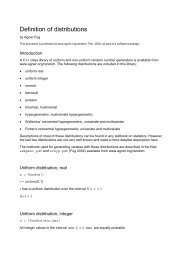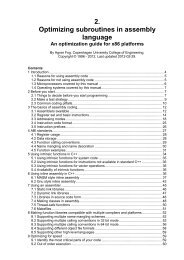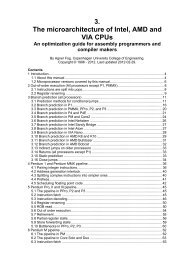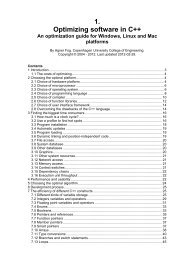4 Instruction tables - Agner Fog
4 Instruction tables - Agner Fog
4 Instruction tables - Agner Fog
Create successful ePaper yourself
Turn your PDF publications into a flip-book with our unique Google optimized e-Paper software.
AMD K7<br />
AMD K7<br />
List of instruction timings and macro-operation breakdown<br />
Explanation of column headings:<br />
<strong>Instruction</strong>:<br />
<strong>Instruction</strong> name. cc means any condition code. For example, Jcc can be JB,<br />
JNE, etc.<br />
Operands:<br />
i = immediate constant, r = any register, r32 = 32-bit register, etc., mm = 64 bit<br />
mmx register, xmm = 128 bit xmm register, sr = segment register, m = any<br />
memory operand including indirect operands, m64 means 64-bit memory operand,<br />
etc.<br />
Ops:<br />
Latency:<br />
Reciprocal throughput:<br />
Execution unit:<br />
Number of macro-operations issued from instruction decoder to schedulers. <strong>Instruction</strong>s<br />
with more than 2 macro-operations use microcode.<br />
This is the delay that the instruction generates in a dependency chain. The<br />
numbers are minimum values. Cache misses, misalignment, and exceptions<br />
may increase the clock counts considerably. Floating point operands are presumed<br />
to be normal numbers. Denormal numbers, NAN's, infinity and exceptions<br />
increase the delays. The latency listed does not include the memory operand<br />
where the operand is listed as register or memory (r/m).<br />
This is also called issue latency. This value indicates the average number of<br />
clock cycles from the execution of an instruction begins to a subsequent independent<br />
instruction of the same kind can begin to execute. A value of 1/3 indicates<br />
that the execution units can handle 3 instructions per clock cycle in one<br />
thread. However, the throughput may be limited by other bottlenecks in the<br />
pipeline.<br />
Indicates which execution unit is used for the macro-operations. ALU means<br />
any of the three integer ALU's. ALU0_1 means that ALU0 and ALU1 are both<br />
used. AGU means any of the three integer address generation units. FADD<br />
means floating point adder unit. FMUL means floating point multiplier unit.<br />
FMISC means floating point store and miscellaneous unit. FA/M means FADD<br />
or FMUL is used. FANY means any of the three floating point units can be<br />
used. Two macro-operations can execute simultaneously if they go to different<br />
execution units.<br />
Integer instructions<br />
<strong>Instruction</strong> Operands Ops Latency Reciprocal Execution Notes<br />
Move instructions<br />
throughput unit<br />
MOV r,r 1 1 1/3 ALU<br />
MOV r,i 1 1 1/3 ALU<br />
Any addr. mode.<br />
Add 1 clk if code<br />
segment base ≠<br />
MOV r8,m8 1 4 1/2 ALU, AGU 0<br />
MOV r16,m16 1 4 1/2 ALU, AGU do.<br />
MOV r32,m32 1 3 1/2 AGU do.<br />
MOV m8,r8H 1 8 1/2 AGU AH, BH, CH, DH<br />
Any other 8-bit<br />
MOV m8,r8L 1 2 1/2 AGU register<br />
Any addressing<br />
MOV m16/32,r 1 2 1/2 AGU mode<br />
MOV m,i 1 2 1/2 AGU<br />
MOV r,sr 1 2 1<br />
Page 7






